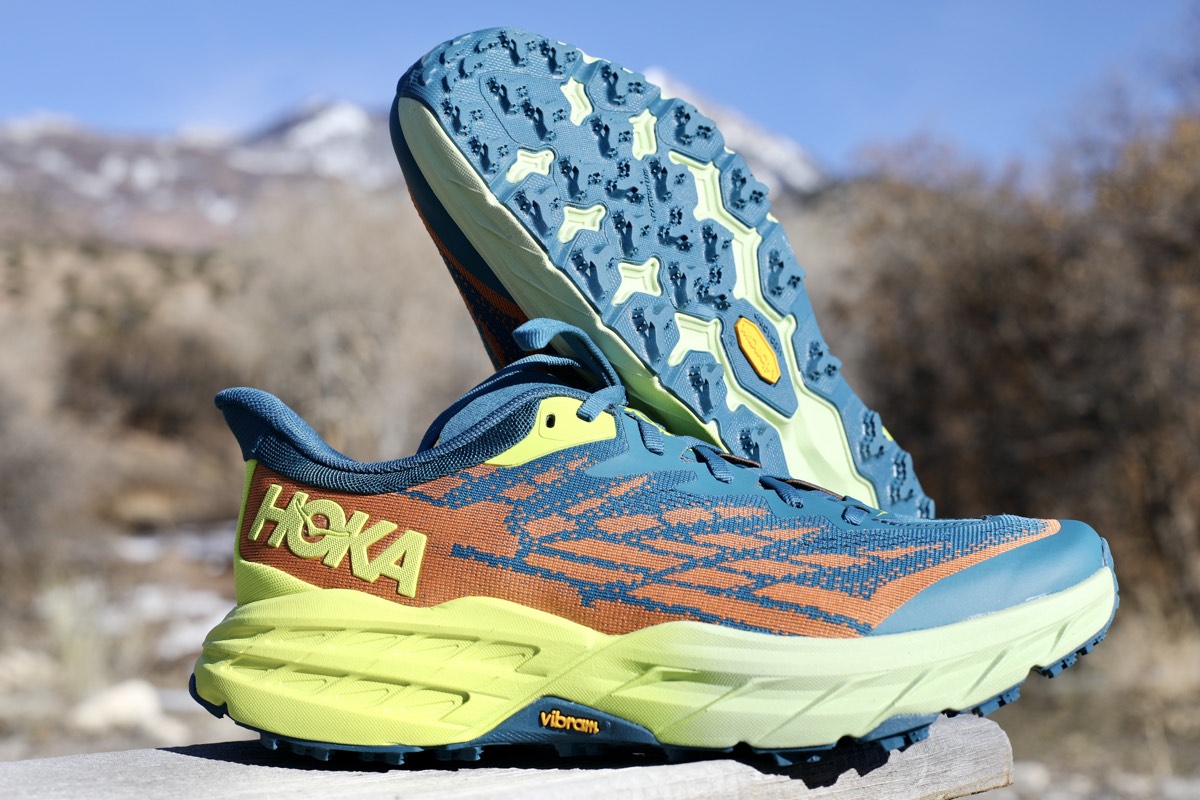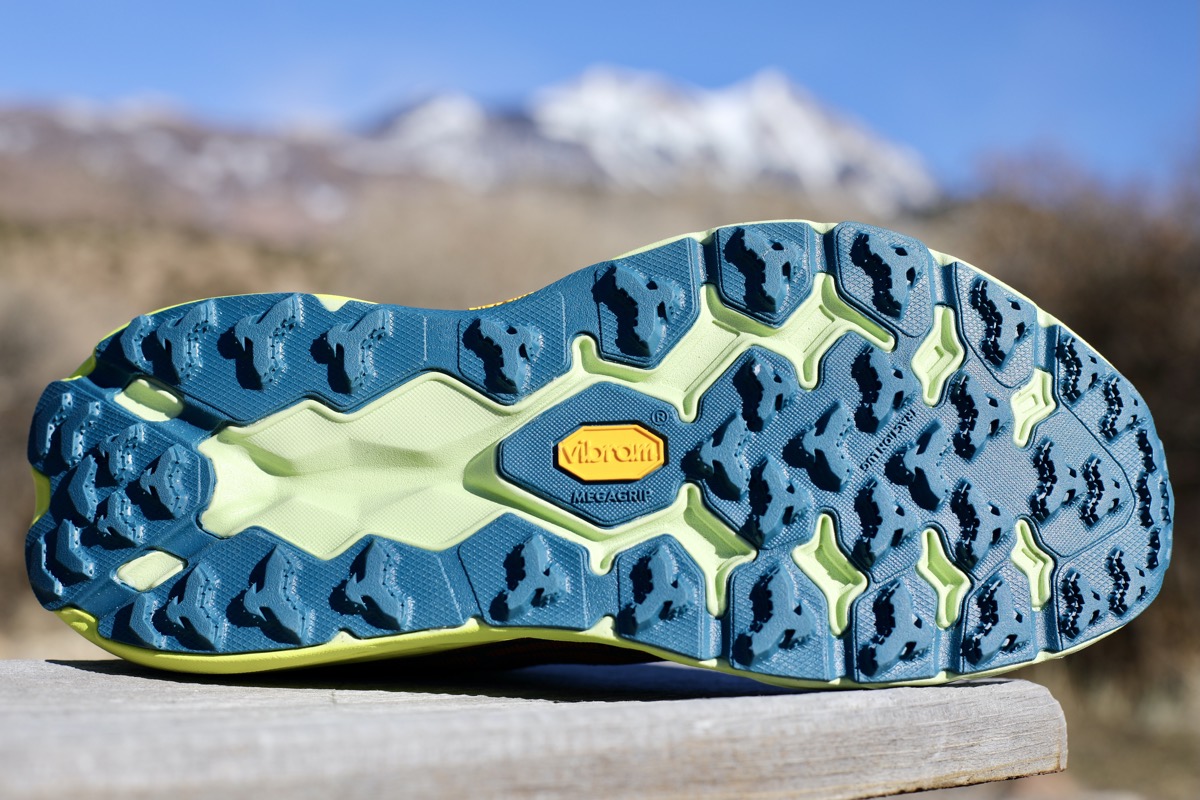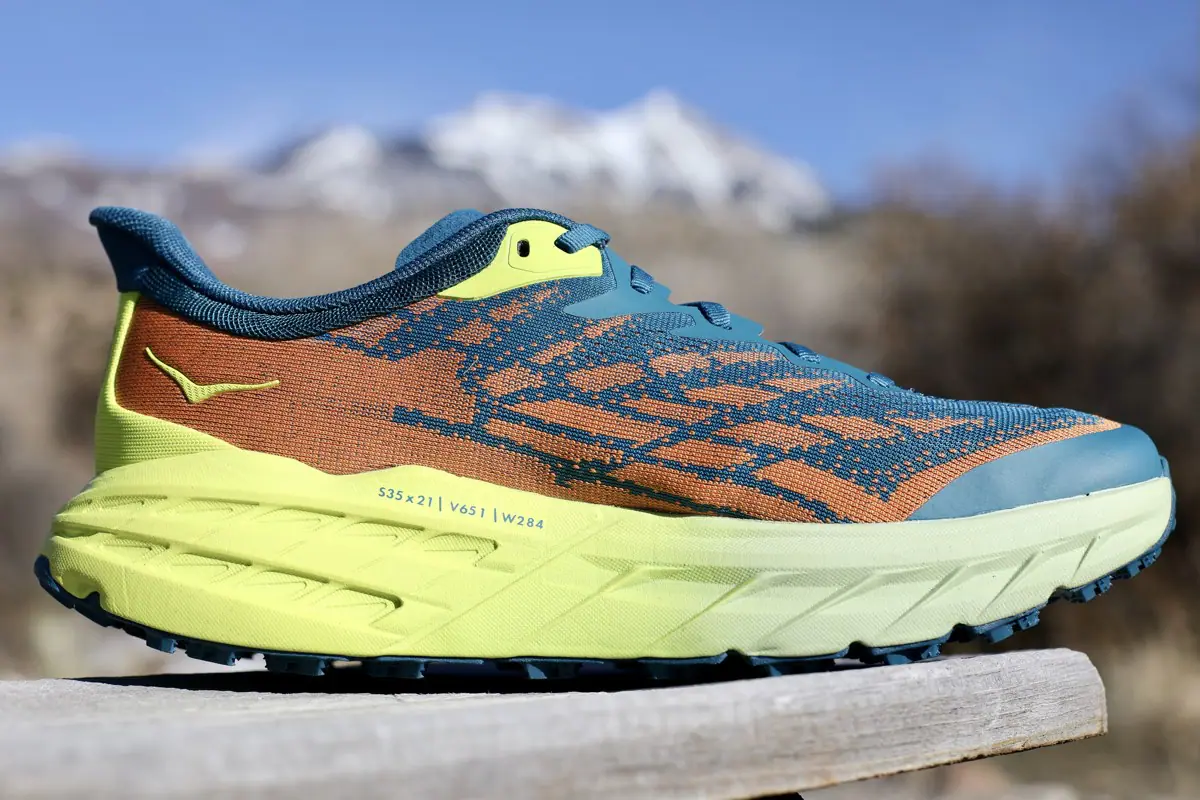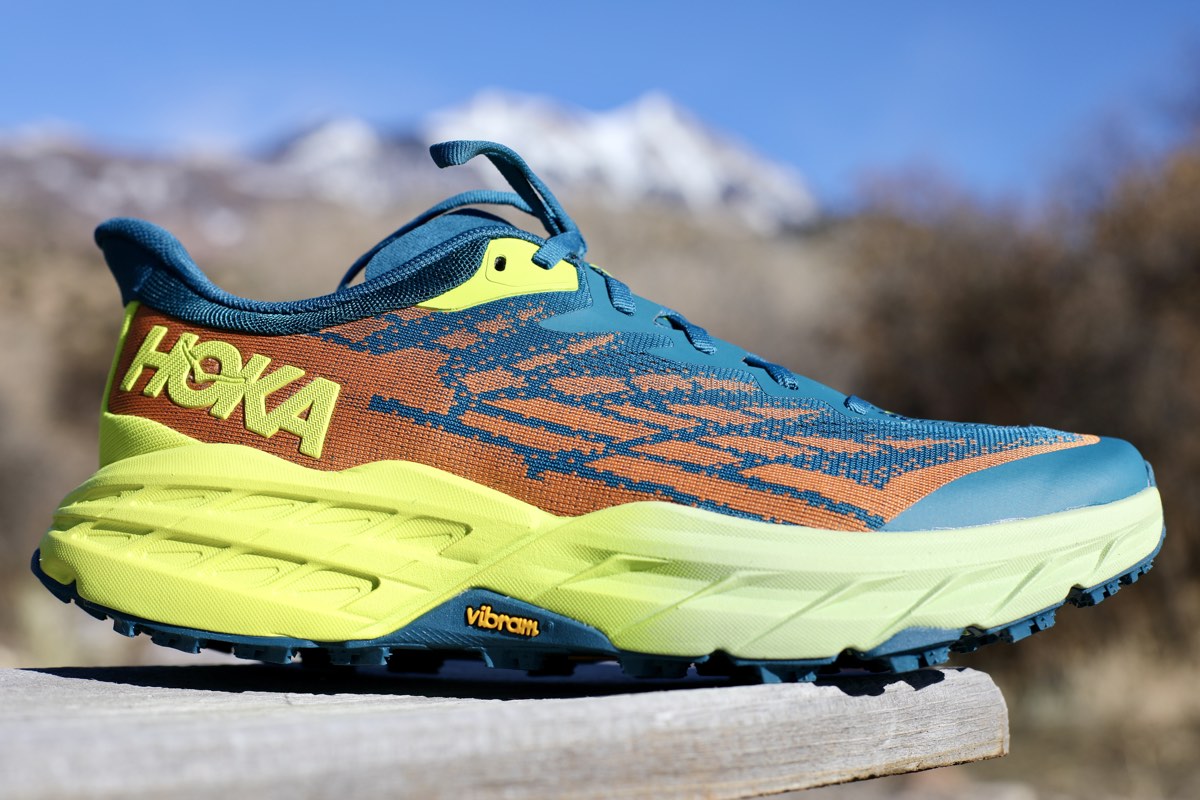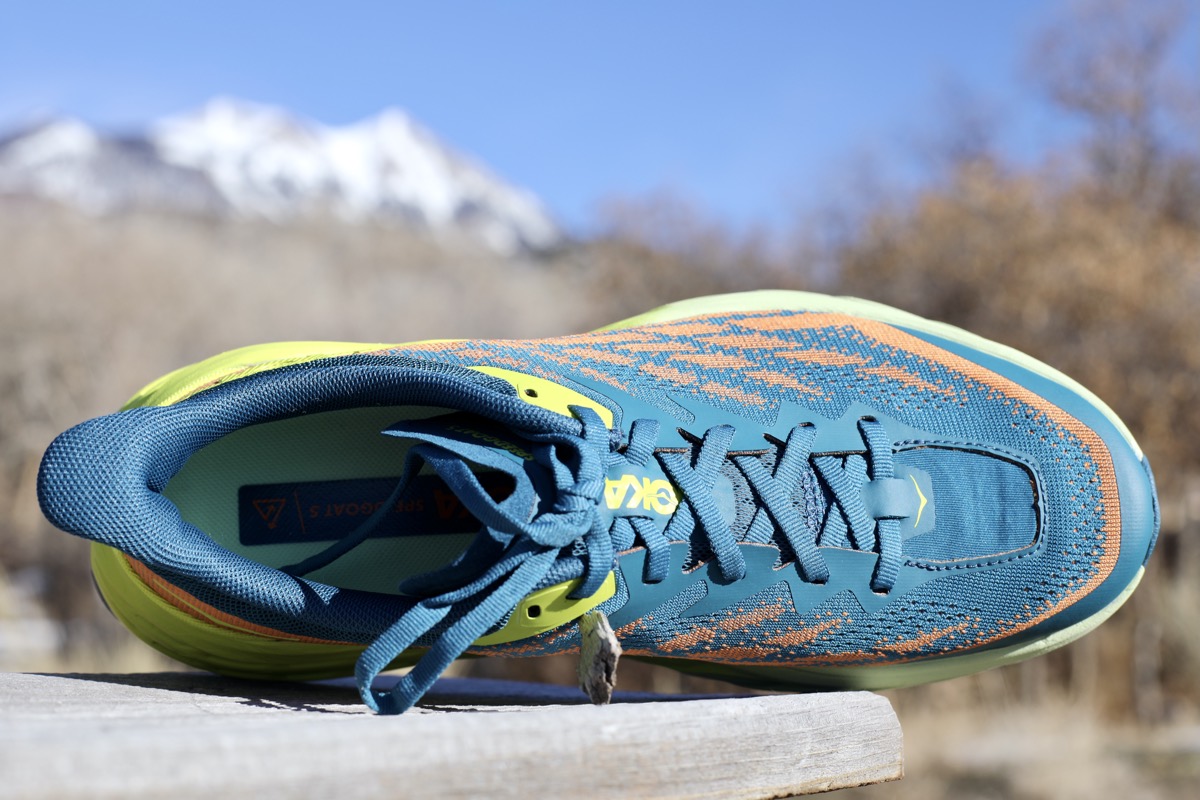For the latest on the Hoka Speedgoat, you can read and watch our Hoka Speedgoat 6 review.
Our Favorite Trail Running Shoes
Check out our Best Trail Running Shoes article to learn about our current favorite trail running shoes!
Hoka One One Speedgoat 5 Review
At long last, the Hoka Speedgoat 5 ($155) is here, with version 5 of this iconic trail ultrarunning shoe released on March 25, 2022.
Longtime fans of the Hoka Speedgoat lineage will find the shoe’s heritage aspects remain present: the Hoka Speedgoat 5’s midsole has all the cushion any ultrarunner could want and the outsole has loads of traction for almost all conditions, though both have been improved.
Where the Hoka Speedgoat 5 diverges from its previous editions is in its heavily updated upper, which gives it a fresh look, despite a similar feel once the shoe is on your foot and you are on the trail.
The iRunFar team loves this shoe enough that we named it one of the top shoes in both our best trail running shoes guide and best cushioned trail running shoes guide.
In this video review, we dive deep into this shoe, comparing it with its predecessors and talking about where it paves a new way.
Shop the Men's Hoka Speedgoat 5Shop the Women's Hoka Speedgoat 5
Hoka Speedgoat 5 Review Transcript
Hey, welcome to Trail Trials, the video review section of iRunFar. My name is Travis Liles and in this video, we’re looking at the Hoka Speedgoat 5.
Let’s start off with the specifications. The Speedgoat 5 is the fifth iteration of the Speedgoat, and in terms of changes, this model is the biggest departure that we’ve had since the Speedgoat moved from version 1 to version 2. Version 4 to 5 is enough of an update that I think it goes beyond the basics that we’ve seen in the previous versions. We have a new upper, slightly different midsole, and they’ve updated a bit of the traction in the outsole.
With all that said, this has a 4-millimeter drop from heel to toe. Its advertised weight is 10.5 ounces. It’s meant for rugged terrain. It’s meant for a little bit of everything. [Editor’s Note: The actual weight for a men’s size 9 is 10.0 ounces (284 grams).]
I’ve got thousands of miles on the Speedgoats over the last handful of years, so I feel pretty good about what I’m about to say. Let’s get up close and personal and check it out.
You can also look back at our previous Hoka Speedgoat 4 review, Hoka Speedgoat 3 review, and Hoka Speedgoat 2 review.
Hoka Speedgoat 5 Outsole
All right, let’s start off by talking about the outsole of the Hoka Speedgoat 5. In general, you’ve got a Vibram Megagrip outsole. This outsole is what you’ve seen, for the most part, in all of the previous versions of Speedgoat. The lug pattern is roughly the same. You have your forward-facing lugs for going uphill. There are some rear-facing lugs in that midfoot area where if you are running downhill, you’re more than likely going to be on that forefoot.
You’ve got some sort of lugs that are backward for braking. You transition to the heel part of the shoe, and you have your rear-facing lugs for more of that slower type of climbing/braking that you’re going to want from the heel pattern.
In general, I think this is a good, all-purpose tread pattern. It works on dry. It works on wet. It works on wet bridges. It works on the road. It just sort of gets out of the way and does the job. It creates enough friction on slick areas that it doesn’t slide all over the place like some trail running shoes that I have, while also not being so sticky and soft that it wears down over time. It works in a lot of conditions.
From a protection standpoint, there’s no rock plate. You’re really counting on the thickness of the midsole to absorb impact, to absorb shock, and to hopefully deflect or be able to absorb any long, pointy object that might pierce the underside of the shoe. Because all of this seafoam green area is exposed foam.
And I can just say in general, I’ve never had a problem where I’ve had something so sharp and so long that it was able to pierce in beyond the sock liner or even really all the way through the midsole. And again, I’ve worn these shoes in a lot of different conditions. Overall, if you like the previous version of the Speedgoat, and the tread pattern and the compound, you’re not going to have any complaints about this version.
If you’re new to the Speedgoat, it’s going to work well in a lot of conditions. The one thing I will note that is different is if you look at these lugs, you’ll notice a little bit of this spiky stuff all over the place. Those are lugs on the lugs and the goal is to create even more surface area for traction.
That is an update from the previous version of the Speedgoat. I can’t say one way or the other if that also means it traps more mud on the bottom. I haven’t really noticed that but it’s something cool that’s going on from a technology standpoint.
Hoka Speedgoat 5 Midsole
All right, let’s move up to the midsole on the Hoka Speedgoat 5. This midsole looks a little bit different. Again, I’ve pulled in my previous version Speedgoat and it’s a little less shiny. It’s more matte-colored. The design language is a little more in line with Hoka’s road shoes than the previous version of the Speedgoat.
This midsole is ever so slightly softer than version 4. This is a midsole compound that was available in the Hoka Evo Speedgoat. There are a couple of similarities between this shoe and that shoe. If you were a fan of the Evo Speedgoat midsole versus the Speedgoat 4, then this is going to be a nice update for you.
What I can say is that in general practice, I do notice it to be a little bit softer feeling. And it’s only in certain scenarios do I notice that that’s the case, but for the most part, it just feels like a good, well-cushioned midsole that provides plenty of cushion, plenty of protection. It’s good if you want to go slow. It’s good if you want to go fast.
Even though it’s tall, it doesn’t feel tipsy. It just really works well and it’s flexible enough. It’s not super stiff. It just works in general. It is a single-density midsole foam all the way around. There are no blockers, there are no cages, there’s nothing like that really doing anything to change your gait or to provide pronation types of control. Single-density foam. Note, it’s just a little bit softer.
Hoka Speedgoat 5 Upper
All right, let’s move on to the Hoka Speedgoat 5’s upper. If I was to say what is the one thing that is the most different that people are going to notice in the Speedgoat 5, it’s the upper.
Back to that Evo Speedgoat comment from earlier. This shares a lot of that type of upper. That was a stretchier, more fabric, and less overlay type of upper, and that’s exactly what’s going on here.
From an upper standpoint, it’s a lot of engineered mesh. In the previous versions, the Speedgoats had a whole lot of overlays on the upper. From the toe, from the midfoot, all around the shoe was kind of this slick plastic-y type of material that created structure on the shoe. And you can see it all the way back to here. You can see all this black that’s on this part of the shoe. Back at the heel is all this rubbery overlay stuff. And that is all gone on this newer version.
For the most part, I think the comfort overall is great. When you step into the shoe, you kind of feel like, “Wow, my foot can relax and spread out and fit into the shoe where it needs to.”
Whereas that previous version of the shoe, maybe you stepped into it if your foot was a little bit wide to the outside like mine is, this area can sometimes feel a little tight or this area feels a little loose, and you kind of have to do some messing with it. This upper molds to what your foot is. And again, that’s really because it’s all just this engineered mesh across the whole shoe.
From a toe standpoint, another thing I always complained about on the previous versions were this area down here and that has been removed again going from that Evo Speedgoat; this is now replaced with some stretchy kind of elastic-y thick material here. It’s sort of what you don’t notice I think is what I like about this.
It’s that before there was this artificial sort of plastic sitting over that my toe seemed to rub against, and it didn’t really give and over time it didn’t loosen up because it was this weird, hard plastic stuff. This lets my foot do what it needs to.
If I’m going downhill, I don’t feel like the top of the shoe is creating some sort of weird plastic-y thing on top of it. My toes can splay out, my foot can move around. There’s just a little bit of relief that happens in that area that didn’t exist in the Speedgoat 4.
Moving toward the heel, continuing that design language, that looks a lot like what the road shoes are. There’s this little tip back here. I don’t know what the purpose is other than aesthetics. But I can say when I wear really low running socks, I feel like more stuff travels into the back of my shoe. If I wear taller socks it’s not a problem, but just a thing to note.
Overall, the heel fit is pretty good. One of the things that is different is the topmost eyelet doesn’t sit back quite as far as the previous version did, or quite as high, or just oriented a little bit different. For the most part, I think the heel is pretty close if not a touch looser than what was in, for my foot, the previous version. If I was really concerned about it, I could pop another hole right here and customize it to fit. I think most people are going to be fine with the heel fit on this shoe.
Let’s talk about this lacing. And because of the lack of the cage, or the overlays that were on the previous version, you’ll note that this is really tight. And that’s because of the comment that I made. This upper is a lot more flexible, and because of that, to get a really good fit you’ve got to kind of pull it down tight. I was almost out of room in terms of locking this down to my foot.
Before, you had these overlays that could create a little bit of tension so you didn’t have to go quite as tight. Case in point. This is how much room I had left on the Speedgoat 4 to tighten down more, and this is how much room I have left on the Speedgoat 5. It’s a more generous fitting upper so you really have to crank it down to get a secure fit if that’s what you’re looking for.
Hoka Speedgoat 5 Overall Impressions
In closing, if you were a Speedgoat wearer before, then the Hoka Speedgoat 5 isn’t going to feel that much different.
However, if you’re someone who has a narrow foot, this is going to be a problem. I don’t have a super-wide foot. In general, all my shoes are standard width. And there aren’t any of those, and I’m kind of at this level of where I’m almost out of room to lock the shoe down any more. Going down a half size, the shoe would be too short for me. That’s just something that you’re going to have to look out for.
I like the update here [in the upper]. They got rid of that stuff. You can see some design language that’s a little bit different. But overall, if you’re a Speedgoat fan, I think you’re going to be pleased with this. It’s less constrictive, a little bit lighter. I think there are all the things that you’re hoping this continues to chip away and get better at. You’ve just got to watch out for those narrow laces.
To learn a little more about why the iRunFar team likes this shoe so much, check our discussion of it in our best trail running shoes guide and best cushioned trail running shoes guide.
Shop the Men's Hoka Speedgoat 5Shop the Women's Hoka Speedgoat 5
Call for Comments
Any questions, comments, or thoughts, leave those in the post below. Thanks for watching. We’ll catch you next time.
[Editor’s Note: If you’re affiliated (i.e., an employee, ambassador, etc.) with a shoe brand, please share your relation in each of your comments on this article. Thanks!]
Our Favorite Trail Running Shoes
Check out our Best Trail Running Shoes article to learn about our current favorite trail running shoes!
